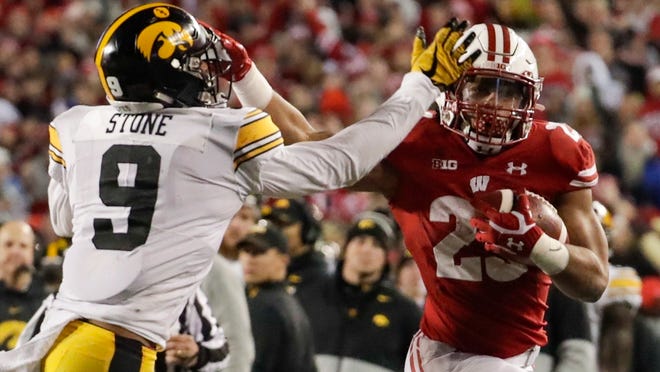No. 16 Wisconsin 24, No. 18 Iowa 22: Here's what we learned
 Mark Emmert
Mark Emmert
MADISON, Wis. — If one play could typify Big Ten Conference football...
If one play could typify the Iowa-Wisconsin rivalry...
It was this.
The No. 18 Hawkeyes had somehow scratched themselves out of a 15-point deficit in the final minutes at Camp Randall Stadium on Saturday.
Needing a two-point conversion to tie the score, Iowa quarterback Nate Stanley stepped back with a shotgun snap and then bolted up the middle. He aimed his 6-foot-4, 243-pound frame squarely at the goal line 3 yards away. He was nearly there.
A pair of Wisconsin defenders met Stanley a foot short, smacking him so hard you could hear it in the upper levels of the stadium.
Stanley was short. So was Iowa, for a fourth consecutive time in this rivalry. And for a third time this season when facing ranked opponents.
No. 16 Wisconsin (7-2, 4-2 Big Ten) prevailed 24-22. The Hawkeyes (6-3, 3-3) saw their Big Ten West title hopes all but end.
One foot short.
The No. 18 Hawkeyes were punchless on offense much of the afternoon, but found life in the passing game in the fourth quarter to nearly erase a 21-6 deficit.
Wisconsin salted the game away, thanks to running back Jonathan Taylor.

Here’s what we learned:
IOWA CANNOT CONTAIN JONATHAN TAYLOR: The Hawkeye gameplan was to do whatever it took to bottle up the star Wisconsin running back. For the first time this season, Iowa even used four linebackers at times. The Hawkeyes left cornerbacks Matt Hankins and Michael Ojemudia in man coverage. None of it worked. Taylor gained 108 yards in the first half alone and was a decoy on both Wisconsin touchdowns, which went to Danny Davis. The only time the Badgers failed to score in Iowa territory was when they inexplicably left Taylor on the sideline at the tail end of a drive that ended with a missed field goal. Thanks to Taylor and a strong rushing game, the Badgers enjoyed a huge advantage in time of possession, which is normally a statistic Iowa dominates. Whenever the Badgers needed a big play, they turned to Taylor. He finished with 250 yards.
HAWKEYES RELY ON GROUND GAME: Stanley entered the game leading the Big Ten in passing yards with 1,950. He rolled out and found tight end Sam LaPorta for a 16-yard gain on Iowa’s first offensive snap. And then … it was a steady diet of running plays. Stanley gained only 11 more yards through the air in the first half. The Hawkeyes failed to convert a third down. Toren Young did gain 45 yards on his eight carries. Tyler Goodson ripped off a 21-yard run in the second quarter. But Iowa couldn’t consistently move the ball and faltered in the red zone again. The lack of a dynamic passing game, or at least the threat of one, was noticeable. And then, suddenly, it all changed. Iowa went up-tempo once it fell behind by two scores. Stanley threw touchdown passes to Nico Ragaini and Tyrone Tracy. He finished with 208 yards passing. And the inevitable question of: Why didn't Iowa pass the ball all game long?
NO ONE IS IMMUNE FROM A BENCHING: Late in the third quarter, Wisconsin quarterback Jack Coan finally made the Hawkeyes pay for selling out to stop the run. Wide receiver Quintez Cephus sprinted past Ojemudia and Coan hit him in stride for a 52-yard gain. Iowa defensive coordinator Phil Parker promptly pulled Ojemudia, a fifth-year senior, and replaced him with sophomore Riley Moss. Two plays later, Coan looked to Cephus again, and Moss couldn’t prevent a 27-yard touchdown.
Iowa returns home to host Minnesota next Saturday.
Mark Emmert covers the Iowa Hawkeyes for the Register. Reach him at memmert@registermedia.com or 319-339-7367. Follow him on Twitter at @MarkEmmert.
No one covers the Hawkeyes like the Register. Subscribe today at Des Moines Register.com/Deal to make sure you never miss a moment.